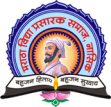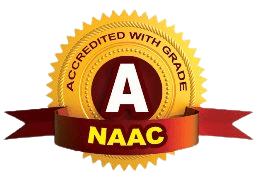Department of Physics
About the Department
The Department of Physics was established in the year 1984 and offers Undergraduate (UG) academic programs. The department has a well-equipped laboratory and is enriched with learning resources such as charts and modern facilities like computers, internet, and LCD projectors. These facilities encourage independent learning among students.
The faculty members are actively involved in research across various fields of Physics. The Head of Department, Dr. Manohar K. Zate, has 10 years of teaching experience.
Vision
To establish a platform for the dissemination and creation of knowledge through teaching and research in Physics at various levels. To help build a scientific society that encourages logical thinking.
Mission
– To offer state-of-the-art academic programs in Physics and interdisciplinary areas.
– To develop a strong interest in Physics among students.
Programs / Courses Offered
| UG | PG |
|---|---|
| B.Sc. | — |
Semester / Credit System (Program-wise)
Credit System: NEP 2020 Pattern
Years: F.Y.B.Sc, S.Y.B.Sc, T.Y.B.Sc
Programme Outcome :(PO) (2024–25)
Physics deals with a wide variety of systems. Certain core theories are universally used by physicists, and these have been experimentally tested many times, found to accurately approximate nature.
Physics uses mathematics to organize and analyze experimental results. From these results, precise or estimated solutions and quantitative outcomes are drawn — leading to new predictions that can be tested.
Modern technologies, especially those based on mathematics like computation, have made computational physics an important and active field of research. The results from physics are largely numerical measurements, essential for advancing scientific understanding.
Programme Specific Outcome:(PSO)
- Explain, evaluate, and interpret theories and assumptions in Physics.
- Access, evaluate, and use scientific information ethically.
- Integrate quantitative and qualitative data to reach logical conclusions.
- Apply sustainability concepts to analyze environmental and societal challenges.
- Stay informed with recent developments in science and technology.
- Use experimental and computational tools to develop analytical skills for real-world problems.
- Gain skills for careers in research, teaching, industry, and related markets.
- Build a progressive and successful career in Physics.
Course Outcomes (CO): F.Y.B.Sc.
| Sr. No. | Syllabus | Course Outcomes (CO) |
|---|---|---|
| 1 | Mechanics | CO 1: The first two chapters of the course will help students to understand basic laws used in mechanics with their applications.
CO 2: Third and fourth chapters will help students understand properties such as surface tension, elasticity & viscosity and their applications in daily life. |
| 2 | Physics Principles & Applications | CO 1: Introduction to basic principles used in atoms & molecules.
CO 2: Understanding the mechanism and applications of laser. CO 3: Knowledge of electromagnetic radiations. CO 4: Study of radio waves, X-rays, visible light, infrared, ultraviolet, etc. CO 5: Learning principles of Pyrometer, solar cell, microwave oven, RADAR, C-T Scan, etc. |
| 3 | Heat & Thermodynamics | CO 1: Understanding the history & origin of thermodynamics concepts through experiments.
CO 2: Study and understanding of thermodynamic laws and processes. CO 3: Application of heat engines, refrigerators, air conditioning, etc. CO 4: Knowledge of principles, types & applications of thermometry. |
| 4 | Electromagnetism | CO 1: Understanding the origin of electric & magnetic fields and their intensities.
CO 2: Learning electric intensity and potential in various materials. CO 3: Study of dielectric materials and their applications. CO 4: Understanding dielectric parameters and magnetic properties for practical applications. CO 5: Study of current loops and forces of attraction/repulsion. |
| 5 | Practical | CO 1: Use of various instruments and equipment.
CO 2: Investigation of theoretical background of experiments. CO 3: Setup and implementation of experimental approaches. CO 4: Group work for planning, implementation and reporting of experiments. CO 5: Maintaining an instructive laboratory logbook. |
S.Y.B.Sc. Physics Course Outcomes (CO)
| Sr. No. | Syllabus | Course Outcomes (COs) |
|---|---|---|
| 1 | Mathematical Method in Physics – I | CO 1: Student will understand the algebra of complex numbers useful in physics courses. CO 2: Student will understand concept of partial differentiation. CO 3: Student will understand the role of partial differential equations in physics. CO 4: Student will understand vector algebra useful in mathematics and physics. CO 5: Student will understand the concept of singular points of differential equations. |
| 2 | Electronics – I | CO 1: Student can apply different theorems and laws to electrical circuits. CO 2: Student will understand the relations in electricity. CO 3: Student will understand parameters, characteristics and working of transistors. CO 4: Student will understand functions of operational amplifiers. CO 5: Student can design circuits using transistors and op-amp applications. CO 6: Student will understand Boolean algebra & logic circuits. |
| 3 | Waves, Oscillations & Sound | CO 1: Student will study underlying principles of oscillations and its development. CO 2: Student can understand and solve equations/graphs for SHM, damped, forced oscillators and waves. CO 3: Student can explain oscillations in terms of energy exchange with practical applications. CO 4: Student can solve numerical problems on undamped, damped, forced oscillation and superposition. CO 5: Student will study sound characteristics, decibel scale and applications. |
| 4 | Optics | CO 1: Student will understand basic concept of wave optics. CO 2: Student can describe interference of light. CO 3: Student can explain diffraction through apertures. CO 4: Student will summarize polarization of electromagnetic waves. CO 5: Understand optical devices based on wave optics. CO 6: Understand phenomena like polarization, diffraction, interference via wave model. CO 7: Analyze examples of interference and diffraction. |
| 5 | Practical | CO 1: Use various instruments and equipment. CO 2: Design experiments to test hypotheses or measure unknowns. CO 3: Investigate the theoretical background of experiments. CO 4: Set up experimental equipment correctly. CO 5: Analyze data, plot graphs and conclude. CO 6: Work in groups to plan and report experiments. CO 7: Maintain a well-documented laboratory logbook. |
B.Sc. Physics – TY Syllabus and Course Outcomes (CO)
| Sr. No. | Syllabus | Course Outcomes (COs) |
|---|---|---|
| 1 | Mathematical Method in Physics-II | CO1: Understand coordinate systems for solving physics problems. CO2: Compare Newtonian and Einstein relativity. CO3: Solve physics problems using differential equations. CO4: Apply special functions in physics problems. |
| 2 | Electrodynamics | CO1: Solve electric intensity and potential using electrostatics. CO2: Explain magnetic fields from electric currents. CO3: Interpret Maxwell’s equations in different media. |
| 3 | Classical Mechanics | CO1: Use conservation laws for solving dynamic problems. CO2: Solve Newton’s laws and Kepler’s law problems. CO3: Explain scattering and canonical transformations. CO4: Apply Lagrangian and Hamiltonian equations. |
| 4 | Atomic and Molecular Physics | CO1: Explain atomic models and applications. CO2: Understand coupling mechanisms. CO3: Develop Zeeman effect experiment. CO4: Know about rotational and vibrational spectra. CO5: Explain Raman spectroscopy applications. |
| 5 | C-Programming & Computational Physics | CO1: Learn syntax of C and basic programming concepts. CO2: Apply numerical methods like Newton-Raphson, Bisection, Trapezoidal rule. CO3: Use graphics commands in C. CO4: Write C programs to solve physics problems. |
| 6 | Elements of Material Science | CO1: Explain electric, mechanical, thermal properties. CO2: Understand crystal defects and diffusion. CO3: Apply phase diagram rules. CO4: Learn polymerization and ceramic materials. CO5: Identify smart materials and applications. |
| 7 | Energy Studies | CO1: Conduct energy audits and consultancy. CO2: Design solar heaters. CO3: Implement solar PV systems. CO4: Work with biomass, biogas, wind systems. CO5: Research on batteries and fuel cells. CO6: Become entrepreneurs in energy. |
| 8 | Physics Workshop Skill | CO: Handle and test various instruments through hands-on learning. |
| 9 | Solid State Physics | CO1: Know crystal structures and properties. CO2: Use X-ray diffraction for material analysis. CO3: Understand band theory of solids. CO4: Learn about magnetic materials and their uses. |
| 10 | Quantum Mechanics | CO1: Compare classical and quantum mechanics. CO2: Learn wave functions and normalization. CO3: Derive and apply Schrodinger equations. CO4: Apply uncertainty principle. CO5: Use operators to find expectation values. CO6: Understand commutator properties and parity. CO7: Get eigenvalues and eigenfunctions. |
| 11 | Thermodynamics & Statistical Physics | CO1: Explain kinetic theory assumptions. CO2: Understand Maxwell’s equations and statistical concepts. CO3: Calculate density states and probability. CO4: Use different ensembles. CO5: Apply Boltzmann, Gibb’s, Fermi Dirac, and Bose Einstein distributions. |
| 12 | Nuclear Physics | CO1: Understand nuclear properties. CO2: Explain radioactivity applications. CO3: Learn nuclear forces and detectors. CO4: Understand nuclear energy and reaction parameters. CO5: Broad understanding of nuclear physics. |
| 13 | Electronics-II | CO1: Explain diodes and applications. CO2: Design amplifiers. CO3: Use Op-Amps and 555 Timer. CO4: Learn power supply ICs. CO5: Understand digital circuits (adder, flip-flops, etc). CO6: Design and analyze electronics circuits. |
| 14 | Laser | CO1: Understand laser principles and characteristics. CO2: Learn pumping schemes. CO3: Study broadening types. CO4: Apply lasers in technology. CO5: Perform laser-based experiments. |
| 15 | Practical Courses | CO: Perform lab experiments to verify physical laws. |
| 16 | Project Course | CO: Learn research methodology and draw conclusions from project work. |
| 17 | Solar PV System: Installation, Repairing & Maintenance | CO1: Learn PV conversion basics. CO2: Hands-on training on solar PV systems. CO3: Become entrepreneur/self-employed. CO4: Analyze bills and design solar systems. |
| 18 | Instrumentation for Agriculture | CO1: Test soil and water. CO2: Develop juice extraction and greenhouses. CO3: Learn greenhouse automation and irrigation instrumentation. |

